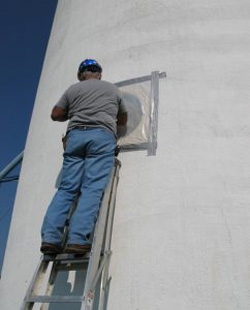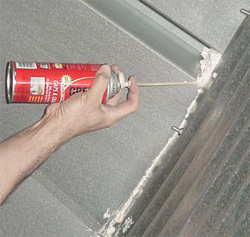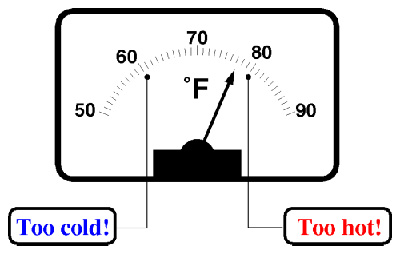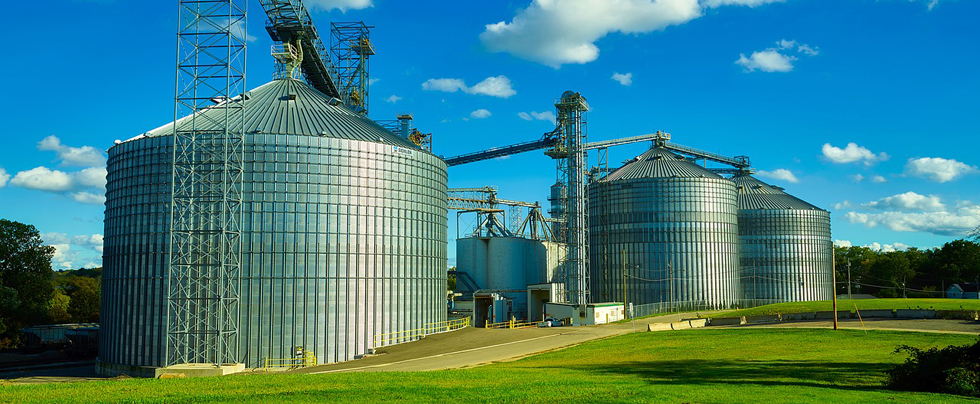Deciding to Fumigate
Advantages of Fumigation
Proper use by highly trained, licensed fumigators is essential.
Fumigants can:
1) quickly eradicate arthropod and/or rodent infestations in commodities and structures.
2) penetrate cracks, crevices, and some packaging materials that may limit the effectiveness of insecticide sprays and dusts to control pests.
3) leave no unsightly, odorous, or hazardous residues if the site is aerated properly.
The ideal fumigant should not change or harm the treated commodity in any way, nor should it leave any residue that could be hazardous during processing or harmful to the consumer.
Tolerance level is the amount of pesticide residue that may legally remain in or on agricultural products after treatment and aeration. Follow the label to be sure fumigant residues never exceed those levels.
Disadvantages of Fumigation
Fumigants:
1) are highly toxic to most living things, including humans. Breathing even small amounts of some fumigants can be fatal. There must be a quick response to problems and emergencies such as spills, leaks, or equipment failures.
2) require special protective equipment: self-contained breathing apparatus (SCBA) and gas detectors.
3) require tightly sealed areas. Leaks can allow fumigant concentration to drop below lethal levels before the required exposure period has elapsed.
4) some products are corrosive or flammable.
5) often require warm temperatures to be effective. This may be a problem in the winter.
Fumigation is time-consuming and expensive. The process usually requires more labor than other pest-control methods. Structural fumigation is disruptive because it requires that tenants / occupants leave. The special hazards and conditions of fumigation necessitate strict legal restrictions and regulation.
Safety Considerations
Fumigants are Restricted-Use pesticides because of their high acute toxicity, primarily by inhalation. They belong to Toxicity Category I (signal words Danger-Poison plus skull and cross bones). Their labels contain information on correct use, safe storage, and correct disposal of residues and empty containers. Labels also give antidotes and first-aid treatment in case of exposure.
People who handle fumigants must be thoroughly familiar with application procedures, safety equipment, first-aid treatment, and disposal procedures. At least two people must be present when using fumigants and both must have the proper respiratory equipment.
The quantity of a fumigant to be applied in a sealed building, vacuum chamber, railcar, or to packed commodities under a tarpaulin is determined by the volume (cubic feet) of the space. In most cases, there is no allowance for the space occupied by the commodity. Label instructions for each fumigant determines the basis for applying the fumigant.
Fumigant Characteristics to Consider
- What is the product's volatility and penetrating power?
- Is the product corrosive, flammable, or potentially explosive?
- What are its warning capabilities and detection methods?
- Are there potential effects on seed germination or quality of the commodities or processed products?
- What is the decomposition time and resulting residues, if any?
- What is the disposal procedure for spent materials or empty containers?
- How can seasonal or forecast weather affect the operation?
[return]
Factors That Affect Fumigation
Sealing the Structure
Proper sealing is most important step in a fumigation. The more tightly sealed the structure, the more efficient the fumigation. Wood and cement blocks are porous, so even well-sealed structures will not hold fumigant gases as well as those made of metal, plastic, masonry, or concrete. Increased dosages and exposure times can compensate for the loss of gas through porous building materials.
Inspect the structure to be fumigated to determine if it can be made sufficiently tight. This includes windows, doors, vents, chimneys, open pipes and structural flaws. Turn off all ventilation, supply air, air conditioning, and any other air moving systems that could negatively affect the fumigation. Seal cracks, holes and openings.

Sealing opening
(photo: Oklahoma State University)
Sealing techniques can include polyethylene sheeting, adhesive tapes and adhesive sprays. Expandable foam or caulking material can work well on structural flaws. Proper sealing will insure sufficient gas levels inside the fumigated structure and will reduce the chance of unwanted exposures outside of the fumigated area.

Sealing seams with silicone caulk
(photo: factsheets.okstate.edu)
Target Pest Species
Susceptibility to fumigants depends on the pest species, its type and stage of development, and its behavior. Fumigant gases usually enter an insect through breathing openings called spiracles. The life stages of the insect that are least active metabolically (e.g., eggs, pupae) are the most difficult to kill by fumigation.

Stored grain insect life cycles (Canada Grain Commission)
- Insects that develop outside grain kernels (secondary pests) are usually more susceptible to fumigants than primary pests that develop inside grain kernels.
- Heavy infestations are more difficult to control. Masses of insects generate large amounts of dust, damaged grain, webbing and cast skins that interfere with fumigant penetration and increase sorption.
- Resistance is the ability of an organism to tolerate a pesticide. Some insects may be sensitive, weakly resistant, or strongly resistant to a specific insecticide. Frequent fumigation at dosages too low to kill all insects promotes problems with resistance.
Fumigant labels give dosages needed for different species of insects and different life stages of those species. For this reason, a fumigator must be familiar with pest biology.
Temperature
Temperature has a major impact on fumigant performance. Poor pest control may result if the fumigation is done outside of the optimal range (60°F to 80°F). Fumigants vaporize and diffuse more slowly at low temperatures. In addition, insect activity and metabolism are slower. This combination reduces killing action, especially when temperatures are below 40°F. Cooler temperatures require higher label rates and longer exposures. In contrast, fumigants vaporize faster and dissipate more quickly at high temperatures.

Optimal temperature range for fumigation (photo: Formilab.ch)
Moisture
Moisture affects fumigant penetration. Commodities/structures with higher moisture content require higher doses of fumigant. However, phosphine tablets and pellets need humidity to generate gas. If the air is too dry or the moisture content of the commodity is too low, these "moisture-activated" fumigants may not react completely. This can result in reduced pest control and increased applicator exposure during cleanup.
Air Movement
Some air movement is essential for effective fumigation. The gas must spread evenly and quickly throughout the commodity or space being treated. It must enter small crevices, cracks or spaces so that a lethal concentration contacts every pest. This even distribution is called equilibrium.
Fumigants also spread faster when their initial concentration is high and the penetration distance is short.
Stratification can occur when the fumigant fails to mix with air. Fans, ducts, or blowers may be necessary to prevent this. Fans are usually sufficient to stir the air in open areas but tightly packed commodities in confined areas may require blowers or ducts to circulate the fumigant.
Structure Construction
Fumigant labels list a range of dosages for specific situations. The most important factor is the tightness of the structure. The ability of a building to hold a fumigant directly affects the amount needed to sustain a lethal concentration throughout. Higher dosages are needed for "loose" structures. Lower doses may be adequate for tightly constructed structures such as railcars or fumigation chambers. It is often better to seal loosely built structures than to use a higher fumigant dose.
[return]





